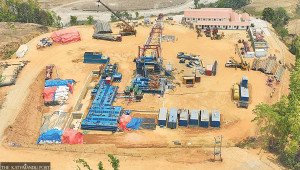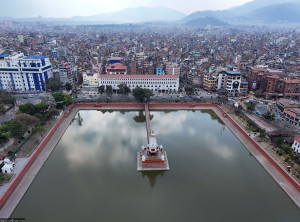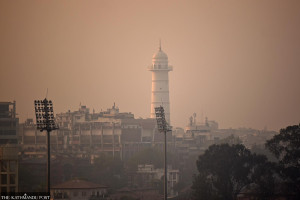Columns
Development partners’ dilemma
History is unlikely to look kindly upon donors that helped an exclusionary regime survive internal challenges.
CK Lal
Supremo KP Sharma Oli is an enigmatic person. First, he stealthily digs himself into a political hole, such as the one he had done in amending the Political Party Act through a hasty issuance of ordinances. Then he shouts that he has been pushed into the pit by his opponents acting in cahoots with foreign forces. Once he has been pulled out from the ditch with an external lifeline, he pats himself on the back for having saved the country.
The Supremo's time-tested tricks no longer distract from his failures on every front of governance. The Covid-19 pandemic is almost out of control. The economy is in shambles. The country is getting increasingly isolated on the diplomatic front as the ruling regime goes on putting all its eggs in the Chinese basket.
To be sure, Nepal has always preferred to have a single patron in the international arena. Up until the fall of their regime in 1951, rulers of the Rana family remained steadfast accomplices of the British Empire. For a brief period in the early-1950s, the newly independent India had a significant say in the internal affairs of the country.
With the opening of the American Embassy at Kathmandu in 1959, the Shah monarchy swiftly shifted its loyalty from London to Washington and accepted the role of a pawn on the Cold War chessboard. A career diplomat had once confided that there used to be a standing order from the secretariat of the Narayanhiti Palace till the late 1990s to consult the closest US mission for guidance if a clear instruction from the Foreign Ministry in Kathmandu was late in coming.
It seems that the leadership of the then Communist Party of Nepal (Unified Marxist-Leninist) began to get feelers from the Communist Party of China (CPC) as soon as President Xi Jinping assumed all authority in 2013 and began to implement his peripheral diplomacy framework with Beijing at the centre of the neighbourhood.
Once Oli was elected the Chairperson of the CPN-UML in 2014, he began the groundwork for a closer relationship with CPC in earnest. In the confusion of the Gorkha earthquakes in 2015, the Chinese connection helped Supremo Oli emerge as the chief designer and main beneficiary of the 16-point conspiracy. The rest, as the cliché goes, is history. Despite his lacklustre leadership and a record of monumental mismanagement, the ethnonational chieftain continues to be hyped as a symbol of political stability.
With Xi Jinping Thought as the guiding principle and Beijing as the guarantor of the Nepal Communist Party regime, Nepal had little hesitation in letting the June 30 deadline for the parliamentary ratification of the Millennium Challenge Corporation (MCC) Compact pass.
It's possible that the MCC impasse wasn't mentioned when US Secretary of State Michael R Pompeo called Foreign Minister Pradeep Gyawali to share lessons of handling the Covid-19 pandemic. But it seems that Kathmandu's diplomatic turn from the Washington Consensus towards the Beijing Consensus is now irreversible; Nepal better begin to brace itself for the diplomatic fallout of the prime minister’s preferences.
Aid trap
It’s an axiom of international relations that foreign aid isn’t charity. In the 1950s, the US aid was aimed at preventing the overflow of Maoism from across the Himalayas. President Dwight Eisenhower bankrolled king Mahendra’s authoritarian rule for the same purpose even as it helped the monarch clear charkose jhadi to resettle his loyalists from the mid-mountains in the southern plains.
With Henry Kissinger’s secret trip to Beijing in 1971, the US interest shifted from countering Maoism to mobilising China in its geopolitical contestations with the Soviets. Nepal went into the tighter embrace of Beijing as Americans abandoned the Khampa Rebellion in Tibet in the early 1970s. Kathmandu remained one of the favourite sites of US-China bonhomie until the implosion of the Soviet Union.
From 1991 onwards, the US establishment in Kathmandu has concentrated its efforts upon winning friends in political parties and influencing people of the media and intelligentsia. With the Soviet Union no longer on the scene and China still under Washington’s grip, Europeans had a free rein on the diplomatic front throughout the 1990s. All that changed with the intensification of the Maoist insurgency, the Narayanhiti Massacre and emergence of China as a credible challenger to the hegemony of the Washington Consensus in the wake of the financial crisis of 2008-09.
An overview of the US aid regime between 1960-2000 in Nepal corroborates findings of scholars elsewhere in the world. The political economy of development aid does primarily benefit the ruling elite. In Nepal, it created what BP Koirala had once called ‘bhuiphutta barga’ meaning a comprador bourgeoisie sans conscience. Once such a class acquires critical mass, institutionalisation of plutocracy gains momentum.
It would be hasty to conclude that aid doesn’t work. The entire East-West Highway owes its existence to donors' largesse with neither the US nor China being one of them. In addition to remittances, foreign aid has been a significant contributor to the marginal gain in the human development index of countries such as Bangladesh and Nepal.
Humanitarian assistance saves lives and improves the life chances of people on the margin. It’s just that most aid programmes fail to spur economic growth. Investments require that the system of governance function in a dependable manner. With their strategic interests triumphing over local needs, donors end up eroding the governing capacity of the receiver.
Fungibility of funds allows recipient regimes to invest lavishly in populist projects. For example, if the World Bank is ready to finance the reconstruction of bridges damaged in the Gorkha earthquakes, Supremo Oli has the freedom of transferring money from transportation projects towards erecting view towers in his constituency. A bigger risk is what economist William Easterly calls the popularity of dictator worship in the name of political stability.
Debilitating debt
According to popular lore in management circles, one of the gurus of the profession, Peter Drucker, once quipped that culture ate strategy for breakfast. Among several factors that social scientist Dor Bahadur Bista identified as causes of continued underdevelopment of Nepal, fatalism topped the list. In addition to an irrational belief in the inevitability of events, fatalism also implies a firm faith in the existing social order.
In the imperial traditions of the Chinese, Bista’s list of cultural traits such as chakari (an extreme form of sycophancy) and afno manchhe (patronage of loyalists) are as important in the bastion of bahunbad that is Nepal. China understands that the ruling regimes in its client countries need to continually grease their support bases with adequate incentives. That is perhaps one of the reasons Beijing allows its largesse to be used for technically grand but economically unviable projects.
Perhaps donors and debtors alike need to realise that the post-conflict formulation of the political economy in Nepal is erroneous. Their beneficence will not be considered an expression of altruism but is likely to be construed as complicity with the ethnonational regime. Presidents for life and prime ministers forever may be the flavour of the season of unreason holding sway for now, but the inevitable democratic revival is unlikely to look kindly upon donors that helped the exclusionary regime survive internal challenges.




 19.43°C Kathmandu
19.43°C Kathmandu









.jpg&w=300&height=200)





